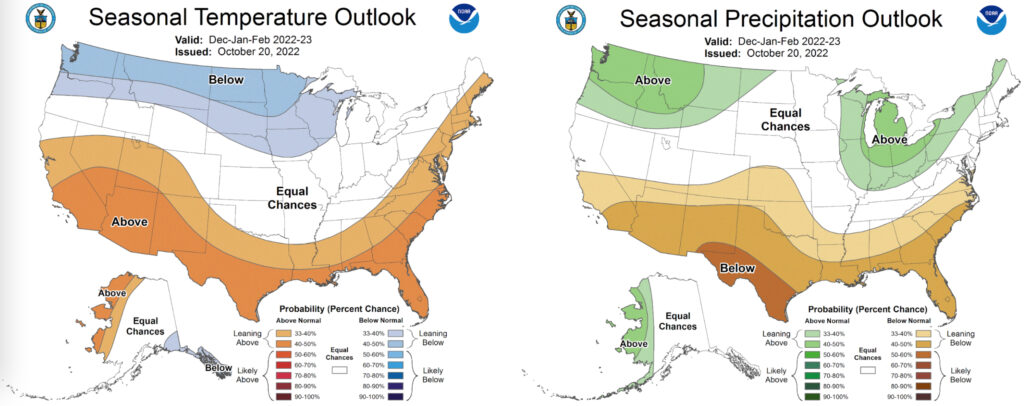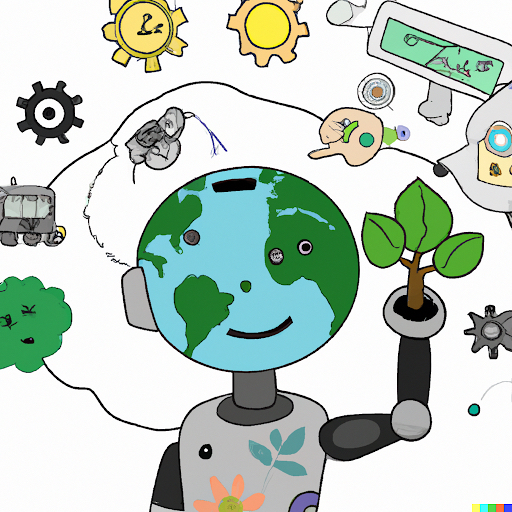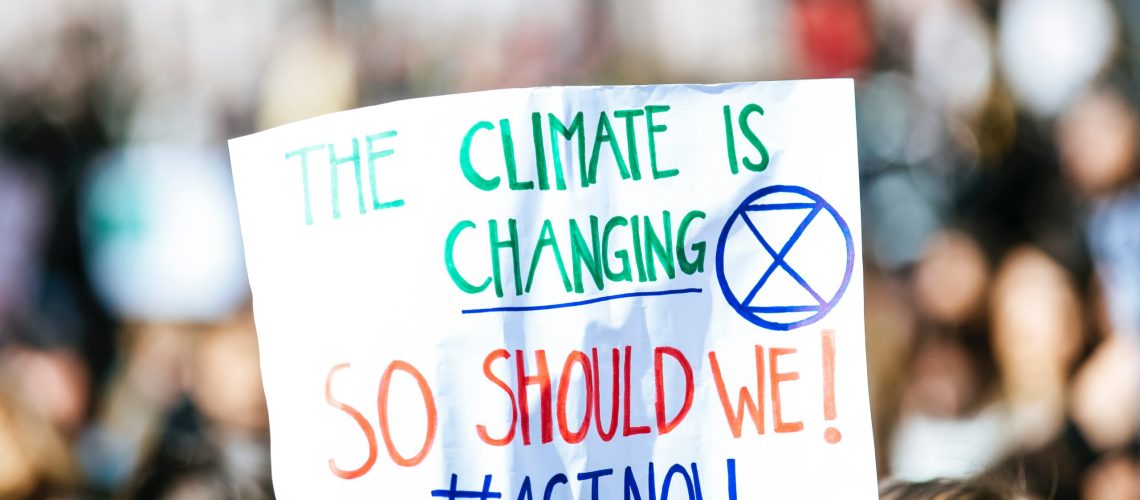Guest Post by Marybeth Arcodia, 2022-2023 Sustainability Leadership Fellow, and Postdoctoral Fellow in the Department of Atmospheric Science at Colorado State University
If we could predict a flooding, drought, or heatwave event one month in advance, how many lives could be spared with more time to prepare? Scientists are making strides in making weather and climate predictions weeks to months in advance, thanks to an emerging understanding of how our climate system is interconnected.
What is a forecast of opportunity?
The climate system is connected largely through atmospheric waves that carry temperature, pressure, and wind signals which impact weather thousands of miles away. On longer timescales, the ocean connects global patterns through ocean circulation and sea level pressure.
Certain atmospheric and oceanic conditions can lead to more predictable states of the climate system resulting in more accurate forecasts, known as forecasts of opportunity. These higher-confidence forecasts typically occur when the most understood aspects of the climate system are in a state which has known connections around the globe. One of the most common of these phenomena is the El Niño Southern Oscillation, or ENSO. ENSO is described by sea surface temperatures in the tropical Pacific Ocean, with warm waters in the tropical Pacific known as an El Niño event and conversely, cold waters result in a La Niña event. ENSO is associated with large storms which disrupt the atmosphere and cause rippling waves, like dropping a stone in a lake. These waves affect United States rainfall and temperature patterns a few weeks to a few months later (see Figure 1 for a visual of how this process works). During El Niño events, for example, Colorado is typically cooler than normal, while during La Niña events, Colorado is typically warmer than normal [1]. Therefore, a monthly forecast for Colorado during an El Niño event would likely forecast below normal temperatures with a high level of confidence thanks to our knowledge of the effects of El Niño.

Effectively Communicating Forecasts
Subseasonal and seasonal forecasts convey different information than the forecasts we are used to seeing on a typical weather app. For example, weather forecasts usually include a 15-day forecast with a high and low temperature, chance of rain, etc. However, climate forecasts extend beyond weather timescales and range from 2 weeks to decades… but most of us really care about what is going to happen in the next few weeks to months. Due to chaos or randomness in the atmosphere, we are not able to make an exact temperature or rainfall forecast for say, one month from today. But we can make forecasts for predicted temperatures and precipitation compared to normal (i.e. chances of above or below normal). The current seasonal outlook for temperature and precipitation probabilities in the United States is found in Fig. 2. These climate forecasts use the known or predicted states of the climate system and knowledge of how certain conditions can affect the U.S. forecasts ranging from 2 weeks to seasonal outlooks (3 months) to one year into the future.

But what good is an accurate forecast if no one heeds it? Climate forecasts, when used correctly, hold powerful information for future planning. Many people, such as decision makers, including government officials and local authorities, farmers, shipping companies, energy sectors, and financial markets, rely on accurate subseasonal to seasonal forecasts. To make proper decisions, the user must learn how to decipher and make informed decisions with a climate forecast, particularly when a forecast of opportunity is possible.
Uncovering Forecasts of Opportunity with AI
Some of my previous research [4] has shown that the atmospheric and oceanic states of the tropical Pacific can affect weather in the United States specifically on subseasonal (i.e., 2 week – 2 month) timescales, leading to potential forecasts of opportunity. In current research with the Barnes’ Group [5] in CSU’s Atmospheric Science Department, we use a type of artificial intelligence (AI), called machine learning [6], to study climate system predictability and forecasts of opportunity [7]. Machine learning can efficiently digest a large amount of information about the climate system and learn complex relationships, making it a powerful tool that can greatly aid in advancing scientific knowledge. Using machine learning approaches, we aim to better understand forecasts of opportunity for subseasonal U.S. rainfall prediction by knowing the state of the tropics [8]. We use interpretable models and apply explainability methods [9,10] to allow us to understand precisely how a model makes its predictions. In my current research, by using these explainable machine learning techniques, we can determine which regions in the tropics the model deemed important for its prediction (such as the El Niño/La Niña region and perhaps even regions we hadn’t looked at before). We can also quantify the machine learning model’s confidence to identify more predictable time periods, i.e. forecasts of opportunity. We can assess how these predictable time periods change over long periods of time and how these predictable states may change in the future [11].

Build (back) stronger, safer, greener
Forecasts of opportunity can be utilized to potentially predict dangerous climate events weeks to months in advance. Sufficient time to prepare for a climate disaster is critical with proper and effective communication of the forecasts and associated impacts. This is especially important for people living in low income communities and communities of color who have been found to be disproportionately more vulnerable to the negative effects of climate change and who may not be able to adequately prepare or recover from climate impacts [13, 14]. But what happens after disaster strikes? Can we work to minimize devastation in the future?
Adaptation strategies need to be implemented to ensure our communities are built to withstand potential climate risks. This includes preparedness for global climate change risks, such as extended droughts, heatwaves, and wildfires, exacerbated mudslides and flooding events, and intensified hurricanes. It is also important that when a community is affected by a climate disaster, communities should be built back more sustainably and climate-resilient. This could mean installing solar panels when homes and buildings are being rebuilt, or building greener infrastructure that is adapted for climate change impacts, such as streets with efficient drainage in areas that flood. Lastly, it is important to not build homes and communities in high-risk areas for climate disasters, such as low-lying barrier islands along coastlines or wildfire-prone regions.
Societal focus needs to turn to more community-wide action and equitable and sustainable solutions advocated for by leaders. Accurate forecasts made weeks to months in advance translate to safer and more efficient evacuations, lowering of dam levels for threatening floods, even proper preparations of food banks and shelters. Knowing how global conditions affect U.S. weather allows management officials and individuals more time to prepare, saving millions in property damage and sparing countless lives. Now is the time to start turning climate disaster experiences into science-informed decision making to build a more sustainable future.
Acknowledgements: I would like to thank Valerie Seitz, Kelsey Malloy, and Rich Karp for helpful feedback on this blog post.
Footnotes:
[1]: CSU Colorado Climate Center: ENSO and Colorado (hyperlink “ENSO and Colorado” – https://climate.colostate.edu/co_enso.html)
[2] Seasoned Chaos- A personality test for our climate system: the basis for forecasting ‘in-between’ (hyperlink “a personality test … in between” – https://seasonedchaos.github.io/a-personality-test-for-our-climate-system-the-basis-for-forecasting-in-between/)
[3] NOAA Climate Prediction Center Seasonal Outlook (all words hyperlink – https://www.cpc.ncep.noaa.gov/products/predictions/long_range/seasonal.php?lead=2)
[4] Arcodia, Marybeth C., Ben P. Kirtman, and Leo SP Siqueira. “How MJO teleconnections and ENSO interference impacts US precipitation.” Journal of climate 33.11 (2020): 4621-4640. (hyperlink – https://journals.ametsoc.org/view/journals/clim/33/11/jcli-d-19-0448.1.xml)
[5] Barnes Group Website (hyperlink text to https://sites.google.com/view/barnesgroup-csu/home)
[6] Machine Learning: An Introduction. Towards Data Science. (hyperlink text – https://towardsdatascience.com/machine-learning-an-introduction-23b84d51e6d0)
[7] Seasoned Chaos. Demystifying Machine Learning in Climate Science (hyperlink “Demystifying… Science” https://seasonedchaos.github.io/Demystifying-Machine-Learning-in-Climate-Science/)
[8] Mayer, K. J., & Barnes, E. A. (2021). Subseasonal forecasts of opportunity identified by an explainable neural network. Geophysical Research Letters, 48. https://agupubs.onlinelibrary.wiley.com/doi/full/10.1029/2020GL092092
[9] Mamalakis, A., Ebert-Uphoff, I., Barnes, E. (2022). Explainable Artificial Intelligence in Meteorology and Climate Science: Model Fine-Tuning, Calibrating Trust and Learning New Science. Invited book chapter. https://dl.acm.org/doi/abs/10.1007/978-3-031-04083-2_16
[11] Mayer, K. J., & Barnes, E. A. (2022). Quantifying the effect of climate change on midlatitude subseasonal prediction skill provided by the tropics. Geophysical Research Letters, 49, e2022GL098663 https://agupubs.onlinelibrary.wiley.com/doi/full/10.1029/2022GL098663
[12] Dalle-2 (hyperlink https://openai.com/dall-e-2/)
[13] Gasper, Rebecca, Andrew Blohm, and Matthias Ruth. “Social and economic impacts of climate change on the urban environment.” Current Opinion in Environmental Sustainability 3.3 (2011): 150-157. https://www.sciencedirect.com/science/article/pii/S187734351000148X?casa_token=YCJM_63DpL4AAAAA:0Jr9UfC7YqiQTpfR7mWEeikxd_miNsdli5N0dZs_Sv9UWYmE1caE0SBBzywTUhNvHAehkfsE1fA
[14] EPA Report Shows Disproportionate Impacts of Climate Change on Socially Vulnerable Populations in the United States (hyperlink – https://www.epa.gov/newsreleases/epa-report-shows-disproportionate-impacts-climate-change-socially-vulnerable)






